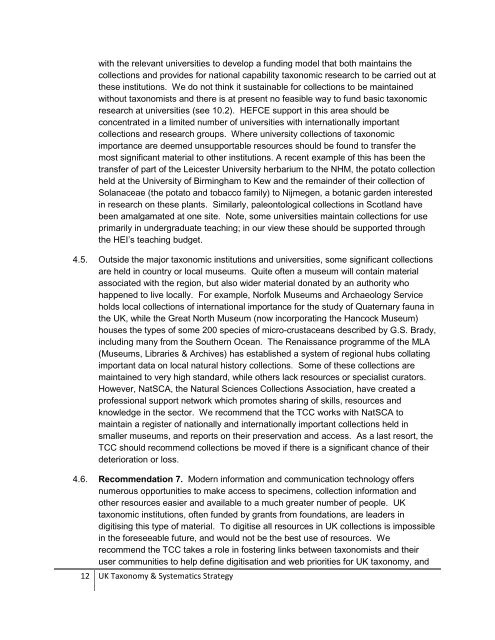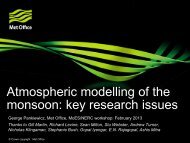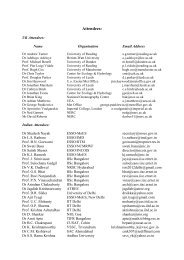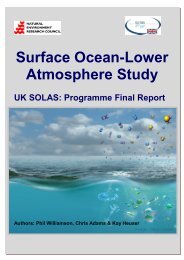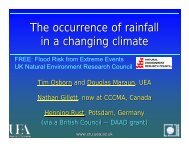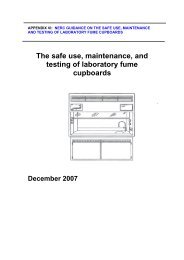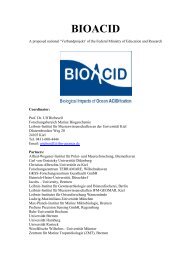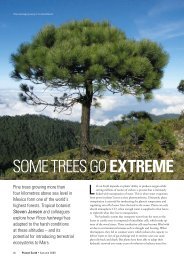Developing a National Strategy in Taxonomy & Systematics (168KB)
Developing a National Strategy in Taxonomy & Systematics (168KB)
Developing a National Strategy in Taxonomy & Systematics (168KB)
Create successful ePaper yourself
Turn your PDF publications into a flip-book with our unique Google optimized e-Paper software.
with the relevant universities to develop a fund<strong>in</strong>g model that both ma<strong>in</strong>ta<strong>in</strong>s the<br />
collections and provides for national capability taxonomic research to be carried out at<br />
these <strong>in</strong>stitutions. We do not th<strong>in</strong>k it susta<strong>in</strong>able for collections to be ma<strong>in</strong>ta<strong>in</strong>ed<br />
without taxonomists and there is at present no feasible way to fund basic taxonomic<br />
research at universities (see 10.2). HEFCE support <strong>in</strong> this area should be<br />
concentrated <strong>in</strong> a limited number of universities with <strong>in</strong>ternationally important<br />
collections and research groups. Where university collections of taxonomic<br />
importance are deemed unsupportable resources should be found to transfer the<br />
most significant material to other <strong>in</strong>stitutions. A recent example of this has been the<br />
transfer of part of the Leicester University herbarium to the NHM, the potato collection<br />
held at the University of Birm<strong>in</strong>gham to Kew and the rema<strong>in</strong>der of their collection of<br />
Solanaceae (the potato and tobacco family) to Nijmegen, a botanic garden <strong>in</strong>terested<br />
<strong>in</strong> research on these plants. Similarly, paleontological collections <strong>in</strong> Scotland have<br />
been amalgamated at one site. Note, some universities ma<strong>in</strong>ta<strong>in</strong> collections for use<br />
primarily <strong>in</strong> undergraduate teach<strong>in</strong>g; <strong>in</strong> our view these should be supported through<br />
the HEI’s teach<strong>in</strong>g budget.<br />
4.5. Outside the major taxonomic <strong>in</strong>stitutions and universities, some significant collections<br />
are held <strong>in</strong> country or local museums. Quite often a museum will conta<strong>in</strong> material<br />
associated with the region, but also wider material donated by an authority who<br />
happened to live locally. For example, Norfolk Museums and Archaeology Service<br />
holds local collections of <strong>in</strong>ternational importance for the study of Quaternary fauna <strong>in</strong><br />
the UK, while the Great North Museum (now <strong>in</strong>corporat<strong>in</strong>g the Hancock Museum)<br />
houses the types of some 200 species of micro-crustaceans described by G.S. Brady,<br />
<strong>in</strong>clud<strong>in</strong>g many from the Southern Ocean. The Renaissance programme of the MLA<br />
(Museums, Libraries & Archives) has established a system of regional hubs collat<strong>in</strong>g<br />
important data on local natural history collections. Some of these collections are<br />
ma<strong>in</strong>ta<strong>in</strong>ed to very high standard, while others lack resources or specialist curators.<br />
However, NatSCA, the Natural Sciences Collections Association, have created a<br />
professional support network which promotes shar<strong>in</strong>g of skills, resources and<br />
knowledge <strong>in</strong> the sector. We recommend that the TCC works with NatSCA to<br />
ma<strong>in</strong>ta<strong>in</strong> a register of nationally and <strong>in</strong>ternationally important collections held <strong>in</strong><br />
smaller museums, and reports on their preservation and access. As a last resort, the<br />
TCC should recommend collections be moved if there is a significant chance of their<br />
deterioration or loss.<br />
4.6. Recommendation 7. Modern <strong>in</strong>formation and communication technology offers<br />
numerous opportunities to make access to specimens, collection <strong>in</strong>formation and<br />
other resources easier and available to a much greater number of people. UK<br />
taxonomic <strong>in</strong>stitutions, often funded by grants from foundations, are leaders <strong>in</strong><br />
digitis<strong>in</strong>g this type of material. To digitise all resources <strong>in</strong> UK collections is impossible<br />
<strong>in</strong> the foreseeable future, and would not be the best use of resources. We<br />
recommend the TCC takes a role <strong>in</strong> foster<strong>in</strong>g l<strong>in</strong>ks between taxonomists and their<br />
user communities to help def<strong>in</strong>e digitisation and web priorities for UK taxonomy, and<br />
12 UK <strong>Taxonomy</strong> & <strong>Systematics</strong> <strong>Strategy</strong>


